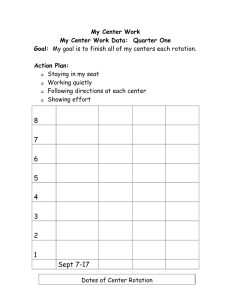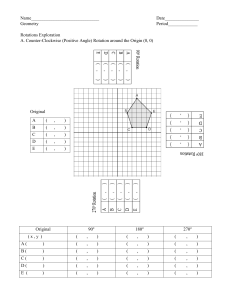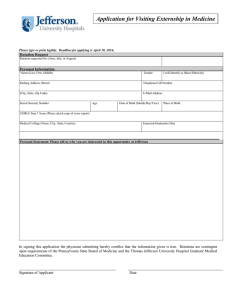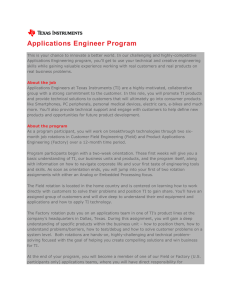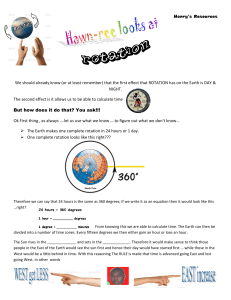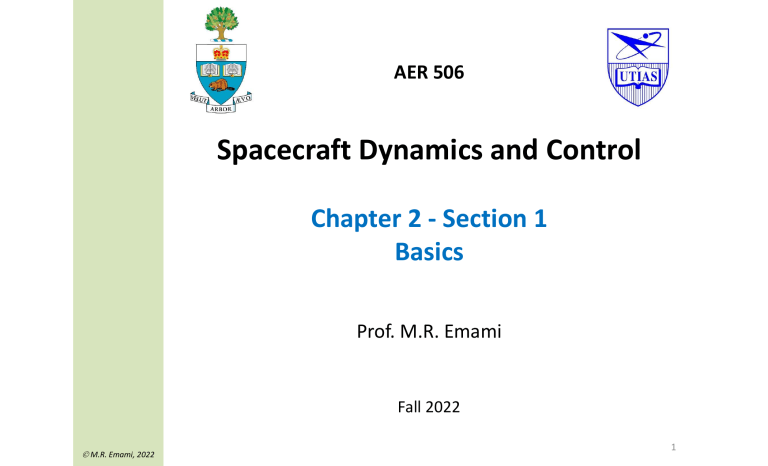
AER 506 1) Vector 2) Celestial Reference Frames 3) Rotation Matrix 4) Basic (Principal) Rotations 5) Cascade of Rotations 6) Rotation (Attitude) Representation Spacecraft Dynamics and Control Chapter 2 - Section 1 Basics Prof. M.R. Emami Fall 2022 M.R. Emami, 2022 1 Outline 1) Vector 2) Celestial Reference Frames Vector 3) Rotation Matrix Celestial Reference Frames 4) Basic (Principal) Rotations Rotation Matrix 5) Cascade of Rotations Basic (Principal) Rotations 6) Rotation (Attitude) Representation Cascade of Rotations Rotation (Attitude) Representation X-Y-Z Fixed (Roll-Pitch-Yaw) Angles Z-X-Z (Classic) Euler Angles Z-Y-Z Euler Angles Axis-Angle Representation M.R. Emami, 2022 2 Vector 1) Vector 2) Celestial Reference Frames 3) Rotation Matrix 4) Basic (Principal) Rotations 5) Cascade of Rotations 6) Rotation (Attitude) Representation 𝑧̂ Mathematical entity with magnitude and direction, often used for representing physical quantities that require magnitude and direction to be fully characterized, e.g., force, velocity, flux, etc. 𝑝 𝑝̂ Reference A set of three mutually-perpendicular unit vectors (axes) Frame 𝑥 , 𝑦 and 𝑧̂ (orthonormal), which intersect at the origin (𝐴 , 𝐴 ) point A and follow a right-handed order (dextral). 𝑥 𝐴≡ 𝐴 ≜ 𝑦 𝑧̂ A 𝑝 𝑦 𝑝 𝑥 = 𝑥 𝑦 (vectrix) 𝑧̂ For computational purposes, a vector 𝑝̂ can be defined (expressed) in a reference frame 𝐴 to have 3 scalers 𝑝 , 𝑝 , and 𝑝 . 𝑝 𝑥 𝑝̂ = 𝑝 𝑥 + 𝑝 𝑦 + 𝑝 𝑧̂ = 𝑝 𝑝 𝑝 𝑦 = 𝑥 𝑦 𝑧̂ 𝑝 𝑝 𝑧̂ Notation: 𝑝 𝑝≜ 𝑝 𝑝 𝑝̂ 𝑥 = 𝑝̂ 𝑦 𝑝̂ 𝑧̂ 𝑥 = 𝑦 𝑧̂ 𝑝̂ 𝑝̂ 𝑝̂ (matrix) NOTE: Mathematically, 𝑝 is not a vector, but a column matrix (consisting of 3 scalars) that represents the definition of vector 𝑝̂ in reference frame 𝐴 . 𝑝̂ = 𝐴 M.R. Emami, 2022 𝑝 NOTE: Vectors by themselves can be treated (and even operated) independently of any reference frame, but once all vectors being considered are expressed in the same reference frame, we can then work only with their scalar components. 3 𝑧̂ Vector Inner Product (scalar): 𝑘=𝑝 1) Vector 2) Celestial Reference Frames 3) Rotation Matrix 4) Basic (Principal) Rotations 5) Cascade of Rotations 6) Rotation (Attitude) Representation 𝑘=𝑝 𝑝 = 𝑝 𝑝 = 𝑝 𝑝 𝑝 cos 𝛼 𝑝 = 𝑝 𝑝 𝛼 𝑝 𝑦 𝑝 Cross Product (vector): 𝑟̂ = 𝑝 × 𝑝 = 𝑝 𝑝̂ 𝑒̂ (𝛼 is the angle between 𝑝 and 𝑝 .) 𝑝 𝑝 𝑝 𝑝 =𝑝 𝑝 +𝑝 𝑝 +𝑝 𝑝 𝑝 𝑝̂ 𝑥 sin 𝛼 𝑒̂ (𝑒̂ is the unit vector perpendicular to 𝑝 and 𝑝 .) 𝑝 (skew-symmetric matrix; 𝑎 = −𝑎 , 𝑎𝑏 = −𝑏𝑎) 𝑝 𝑝 0 = 𝑝 −𝑝 Example: 𝑎 𝑏 × 𝑐̂ = 𝑐̂ 𝑟= Useful Identities −𝑝 0 𝑝 𝑝 −𝑝 0 𝑝 𝑝 𝑝 𝑎×𝑏 =𝑏 −𝑝 𝑝 + 𝑝 𝑝 = 𝑝 𝑝 −𝑝 𝑝 −𝑝 𝑝 + 𝑝 𝑝 𝑐̂ × 𝑎 𝑎 𝑏 𝑐= 𝑐 𝑎 𝑏= 𝑏 𝑎 × 𝑏 × 𝑐̂ = 𝑎 𝑐̂ 𝑏 − 𝑎 𝑏 𝑐̂ = 𝑏 𝑎 𝑐̂ − 𝑐̂ 𝑎 𝑏 𝑎 𝑏= 𝑏 𝑎 − 𝑎 𝑏 𝐼 𝑐̃ 𝑎 (bac-cab identity) (𝐼 is the 3 × 3 identity matrix.) NOTE: The cross-product operation does not have the associativity property, i.e., 𝑎 × 𝑏 × 𝑐̂ = 𝑎 × 𝑏 × 𝑐̂ + 𝑏 × 𝑎 × 𝑐̂ ≠ 𝑎 × 𝑏 × 𝑐̂ M.R. Emami, 2022 4 Celestial Reference Frames Equatorial Plane: The plane normal to the Earth’s axis of rotation about itself. Ecliptic Plane: The orbital plane of Earth’s centre about the Sun. 1) Vector 2) Celestial Reference Frames Obliquity of the Ecliptic (𝜀): The angle between the Earth’s axis of rotation and normal line to the ecliptic plane (𝜀 ≅ 23.44° ). 3) Rotation Matrix 4) Basic (Principal) Rotations Vernal Equinox Line (𝛾): The line passing through the centre of Earth and the Sun on the first day of spring on the northern hemisphere, when the noontime sun crosses the equator from south to north. (The number of hours of daylight and darkness are equal.) Heliocentric-Ecliptic Reference Frame 𝐻 : 5) Cascade of Rotations Origin 𝑂 at the Sun’s centre of mass 6) Rotation (Attitude) Representation 𝑥 along vernal equinox 𝛾 (the Earth-Sun direction) Vernal (Spring) Equinox (first day of spring, March 21) 𝑧̂ normal to Ecliptic plane 𝑦 in the Ecliptic plane, so that 𝑥 × 𝑦 = 𝑧̂ 𝑧̂ Celestial Axis Rotation Axis 𝑦 𝑥 Hibernal (Winter) Solstice (first day of winter, December 21) Estival (Summer) Solstice (first day of summer, June 21) M.R. Emami, 2022 Autumnal (Fall) Equinox (first day of autumn, September 23) 5 Celestial Reference Frames Earth-centred Inertial (Geocentric-Equatorial) Reference Frame 𝐺 : Origin 𝑂 at the Earth’s centre of mass 1) Vector 2) Celestial Reference Frames 3) 4) Rotation Matrix Basic (Principal) Rotations 5) Cascade of Rotations 6) Rotation (Attitude) Representation 𝑥 (𝐼 ) along vernal equinox 𝛾 (the Earth-Sun direction) 𝑧̂ (𝐾) along the Earth’s North Pole (normal to Equatorial plane) 𝑦 (𝐽) in the Equatorial plane, so that 𝑥 × 𝑦 = 𝑧̂ 𝑧̂ OG 𝑦 Ecliptic Plane 𝑥 Perifocal Reference Frame 𝑃 : Origin 𝑂 at the Earth’s centre of mass 𝑥 (𝑝̂ ) toward the orbit perigee 𝑧̂ 𝑧̂ (𝑤 ) normal to orbital plane 𝑦 (𝑞 ) in the orbital plane, so that 𝑥 × 𝑦 = 𝑧̂ Orbiting Reference Frame 𝑂 : 𝑦 𝑧̂ 𝑥 𝑥 OO OP 𝑦 Origin 𝑂 at the Earth’s centre of mass 𝑥 toward the satellite 𝑧̂ normal to orbit plane M.R. Emami, 2022 𝑦 in the orbital plane, so that 𝑥 × 𝑦 = 𝑧̂ 6 Celestial Reference Frames Local Vertical Local Horizontal Reference Frame 𝐿 : Origin 𝑂 at the satellite’s centre of mass 1) Vector 𝑥 along outward radial from Earth to satellite, defining direction of satellite’s local vertical 2) Celestial Reference Frames 𝑧̂ normal to the orbital plane (in the direction of satellite’s angular momentum vector) 𝑦 in orbital plane, so that 𝑥 × 𝑦 = 𝑧̂ , defining direction of satellite’s local horizon 3) Rotation Matrix 4) Basic (Principal) Rotations 𝑥 pointing in the direction of (but not necessarily parallel to) satellite’s velocity vector 5) Cascade of Rotations 𝑧̂ pointing toward (but not necessarily along) Earth’s centre of mass in orbital plan and perpendicular to 𝑥 6) Rotation (Attitude) Representation 𝑦 dextral frame, so that 𝑥 × 𝑦 = 𝑧̂ Body-fixed Reference Frame 𝐵 (attached to satellite): Origin 𝑂 at the satellite’s centre of mass Inertial Frame: Nonrotational with its origin stationary or moving at a constant velocity (w.r.t. an inertial frame). NOTE: Some of the reference frames may be assumed as inertial if Newton’s laws hold relative to them with a reasonable accuracy. 𝑧̂ 𝑥 𝑧̂ 𝑦 OL 𝑧̂ 𝑧̂ 𝑥 𝑥 𝑥 OO OB 𝑦 𝑦 OP 𝑦 Frame 𝐻 can be assumed as inertial for orbital dynamics of Solar System. M.R. Emami, 2022 Frames 𝐺 and 𝑃 can be assumed as inertial for studying satellite orbital dynamics. 7 Rotation Matrix 𝑝̂ = 𝐴 1) Vector 2) Celestial Reference Frames 3) Rotation Matrix 4) Basic (Principal) Rotations 5) Cascade of Rotations 6) Rotation (Attitude) Representation 𝐴𝐴 𝑥 𝑦 𝑧̂ 𝑥 𝑥 𝑥 𝑥 𝑦 𝑧̂ 𝑦 𝑦 𝑦 𝑥 𝑦 𝑧̂ 𝑝=𝐵 𝑝 𝑝 = 𝐴𝐵 𝑝 𝑧̂ 𝑧̂ 𝑧̂ 𝑥 𝑝= 𝑦 𝑧̂ 𝑥 𝑦 𝑧̂ 𝑦 𝑦 𝑦 𝑥 𝑦 𝑧̂ 𝑧̂ 𝑧̂ 𝑧̂ 𝑝 𝑅 1 0 0 1 0 0 0 0 1 𝑥 𝑝= 𝑦 𝑧̂ Rotation Matrix: 𝑥 𝑥 𝑥 𝑥 𝑦 𝑧̂ 𝑝= 𝑅 𝑝 𝑥 𝑅 = 𝑦 𝑧̂ = M.R. Emami, 2022 𝑥 𝑥 𝑥 𝑅 𝑦 𝑦 𝑦 𝑥 𝑥 𝑥 𝑥 𝑥 𝑦 𝑧̂ 𝑥 𝑦 𝑧̂ 𝑦 𝑧̂ 𝑧̂ 𝑧̂ 𝑦 𝑦 𝑦 𝑝 𝑥 𝑦 𝑧̂ 𝑧̂ 𝑧̂ 𝑧̂ 𝑥 = 𝑥 𝑥 𝑧 𝑐𝑜𝑠 𝜃 𝑐𝑜𝑠 𝜃 𝑐𝑜𝑠 𝜃 = 𝑐𝑜𝑠 𝜃 𝑐𝑜𝑠 𝜃 𝑐𝑜𝑠 𝜃 𝑐𝑜𝑠 𝜃 𝑐𝑜𝑠 𝜃 𝑐𝑜𝑠 𝜃 𝑥 𝑦 𝑧̂ 𝑦 𝑦 𝑦 𝑥 𝑦 𝑧̂ 𝑧̂ 𝑧̂ 𝑧̂ 𝑥 𝑦 𝑧̂ Direction Cosine (angle between 𝑧̂ and 𝑥 ) represents the rotation of frame 𝐵 with respect to frame 𝐴 . 8 Rotation Matrix Some Properties: 1) Vector 2) Celestial Reference Frames 3) 4) Rotation Matrix 𝑅= 𝑋 Cascade of Rotations 6) Rotation (Attitude) Representation 𝑌 𝑍 Inverse 𝑅 Basic (Principal) Rotations 5) Orthonormality 𝑋 𝑋=1 𝑋 𝑌=0 𝑌 𝑌=1 𝑋 𝑍=0 𝑍 𝑍=1 𝑌 𝑍=0 𝑥 𝑅 = 𝑥 𝑦 𝑦 𝑧 𝑅 = 𝑅 𝑧 1 0 = 0 1 0 0 0 0 1 = 𝑅 Determinant of a rotation matrix is +1. Useful Identities 𝑝= 𝑅 𝑅 𝑝 𝑅 = 𝑅 𝑝 = 𝑅 𝑝 𝑅 𝑝 𝑅 NOTE: A rotation matrix can also be viewed as an operator that rotates a vector 𝑝̂ to a new vector 𝑝̂ in a given reference frame 𝐴 . 𝑝 = 𝑅 𝑝 M.R. Emami, 2022 Matrix 𝑅 is the rotation matrix of a (hypothetical) frame 𝐵 with respect to 𝐴 , which can be obtained by a reverse rotation of 𝑝̂ to 𝑝̂ . 9 Basic (Principal) Rotations 1) Vector 2) Celestial Reference Frames 3) Rotation Matrix 4) Basic (Principal) Rotations 5) Cascade of Rotations 6) Rotation (Attitude) Representation About 𝑧̂ axis: 𝑐𝛼 𝑅 = 𝑅 𝛼 = 𝑠𝛼 0 About 𝑦 axis: 𝑐𝛽 𝑅 =𝑅 𝛽 = 0 −𝑠𝛽 About 𝑥 axis: M.R. Emami, 2022 −𝑠𝛼 𝑐𝛼 0 0 0 1 0 1 0 𝑠𝛽 0 𝑐𝛽 1 0 𝑅 = 𝑅 𝛾 = 0 𝑐𝛾 0 𝑠𝛾 0 −𝑠𝛾 𝑐𝛾 10 Cascade of Rotations About fixed axes: 1) Vector 2) Celestial Reference Frames 3) Rotation Matrix 4) Basic (Principal) Rotations 5) Cascade of Rotations 6) Rotation (Attitude) Representation order of rotations 𝑅 𝛾, 𝛽, 𝛼 = 𝑅 𝛼 ⋅ 𝑅 𝛽 ⋅ 𝑅 𝛾 About moving axes: order of rotations 𝑅 M.R. Emami, 2022 𝛼, 𝛽, 𝛾 = 𝑅 𝛼 ⋅ 𝑅 NOTE: Three rotations taken about fixed axes yield the same final orientation as the same three rotations taken in the opposite order about the axes of the moving frames. 𝛽 ⋅𝑅 𝑅 𝛾 𝛾, 𝛽, 𝛼 = 𝑅 𝛼, 𝛽, 𝛾 11 Rotation (Attitude) Representation X-Y-Z Fixed (Roll-Pitch-Yaw) Angles 1) Vector 2) Celestial Reference Frames 3) Rotation Matrix 4) Basic (Principal) Rotations 5) Cascade of Rotations 6) Rotation (Attitude) Representation 𝑅 𝛾̅ , 𝛽̅ , 𝛼 = 𝑅 𝛼 ⋅ 𝑅 𝛽̅ ⋅ 𝑅 𝛾̅ 𝑅 𝑐𝛼 𝑐𝛽̅ 𝛾̅ , 𝛽̅ , 𝛼 = 𝑠𝛼 𝑐𝛽̅ −𝑠𝛽̅ 𝑐𝛼 = 𝑠𝛼 0 −𝑠𝛼 𝑐𝛼 0 0 𝑐𝛽̅ 0 0 1 −𝑠𝛽̅ 𝑐𝛼 𝑠𝛽̅ 𝑠𝛾̅ − 𝑠𝛼 𝑐𝛾̅ 𝑠𝛼 𝑠𝛽̅ 𝑠𝛾̅ + 𝑐𝛼 𝑐𝛾̅ 𝑐𝛽̅𝑠𝛾̅ 0 1 0 𝑠𝛽̅ 0 𝑐𝛽̅ 𝑅 𝑟 𝑟 𝑟 𝑟 𝑟 𝑟 𝛼 = 𝐴𝑡𝑎𝑛2 𝛾̅ = 𝐴𝑡𝑎𝑛2 𝑟 𝑟 0 𝑐𝛾̅ 𝑠𝛾̅ 0 −𝑠𝛾̅ 𝑐𝛾̅ 𝑐𝛼 𝑠𝛽̅𝑐𝛾̅ + 𝑠𝛼 𝑠𝛾̅ 𝑠𝛼 𝑠𝛽̅ 𝑐𝛾̅ − 𝑐𝛼 𝑠𝛾̅ 𝑐𝛽̅ 𝑐𝛾̅ 𝛽̅ = 𝐴𝑡𝑎𝑛2 −𝑟 , ± 𝑟 + 𝑟 𝑟 𝛾̅ , 𝛽̅ , 𝛼 = 𝑟 𝑟 1 0 0 , 𝑐𝛽̅ , 𝑐𝛽̅ 𝑟 𝑟 𝑐𝛽̅ 𝑐𝛽̅ Atan2 𝑥, 𝑦 computes tan 𝑥 ⁄𝑦 , but uses the signs of both 𝑥 and 𝑦 to determine the quadrant in which the resulting angle lies. A unique solution exists for −90° < 𝛽̅ < +90° . 𝛽̅ = ±90 M.R. Emami, 2022 One degree of Convention freedom is lost. (degeneracy) 𝛽̅ = +90 : Set 𝛼 = 0 & Compute 𝛾̅ = Atan2 𝑟 , 𝑟 𝛽̅ = −90 : Set 𝛼 = 0 & Compute 𝛾̅ = − Atan2 𝑟 , 𝑟 . . 12 Rotation (Attitude) Representation Z-X-Z (Classic) Euler Angles 1) Vector 2) Celestial Reference Frames 3) Rotation Matrix 4) Basic (Principal) Rotations 5) Cascade of Rotations 6) Rotation (Attitude) Representation 𝑅 𝑅 𝛼, 𝛽, 𝛾 = 𝑅 𝛼 ⋅ 𝑅 𝑟 𝛼, 𝛽, 𝛾 = 𝑟 𝑟 𝑟 𝑟 𝑟 𝑟 𝑟 𝑟 𝛽 ⋅𝑅 −𝑠𝛼𝑐𝛽𝑠𝛾 + 𝑐𝛼𝑐𝛾 𝛾 = 𝑐𝛼𝑐𝛽𝑠𝛾 + 𝑠𝛼𝑐𝛾 𝑠𝛽𝑠𝛾 −𝑠𝛼𝑐𝛽𝑐𝛾 − 𝑐𝛼𝑠𝛾 𝑐𝛼𝑐𝛽𝑐𝛾 − 𝑠𝛼𝑠𝛾 𝑠𝛽𝑐𝛾 𝛽 = 𝐴𝑡𝑎𝑛2 ± 𝑟 + 𝑟 , 𝑟 𝛼 = 𝐴𝑡𝑎𝑛2 𝑟 ⁄𝑠𝛽 , − 𝑟 ⁄𝑠𝛽 𝛾 = 𝐴𝑡𝑎𝑛2 𝑟 ⁄𝑠𝛽 , 𝑟 ⁄𝑠𝛽 𝑠𝛼𝑠𝛽 −𝑐𝛼𝑠𝛽 𝑐𝛽 Atan2 𝑥, 𝑦 computes tan 𝑥 ⁄𝑦 , but uses the signs of both 𝑥 and 𝑦 to determine the quadrant in which the resulting angle lies. A unique solution exists for 0 < 𝛽 < 180° . 𝛽 = 0 or 180 One degree of Convention freedom is lost. (degeneracy) 𝛽 = 0: Set 𝛼 = 0 & Compute 𝛾 = Atan2 −𝑟 , 𝑟 . 𝛽 = 180 : Set 𝛼 = 0 & Compute 𝛾 = − Atan2 𝑟 , −𝑟 NOTE: M.R. Emami, 2022 The same final attitude can be obtained using Euler angles by a cascade of rotations about the fixed axes (of frame 𝐴 ) if the order of rotations is reversed, i.e., first a rotation of 𝛾 about 𝑧̂ , then a rotation of 𝛽 about 𝑥 , and then a rotation of 𝛼 about 𝑧̂ . 13 . Rotation (Attitude) Representation Z-Y-Z Euler Angles 1) Vector 2) Celestial Reference Frames 3) Rotation Matrix 4) Basic (Principal) Rotations 5) Cascade of Rotations 6) Rotation (Attitude) Representation 𝑅 𝑅 𝛼, 𝛽, 𝛾 = 𝑅 𝛼 ⋅ 𝑅 𝑟 𝛼, 𝛽, 𝛾 = 𝑟 𝑟 𝑟 𝑟 𝑟 𝑟 𝑟 𝑟 𝛽 ⋅𝑅 𝑐𝛼𝑐𝛽𝑐𝛾 − 𝑠𝛼𝑠𝛾 𝛾 = 𝑠𝛼𝑐𝛽𝑐𝛾 + 𝑐𝛼𝑠𝛾 −𝑠𝛽𝑐𝛾 −𝑐𝛼𝑐𝛽𝑠𝛾 − 𝑠𝛼𝑐𝛾 −𝑠𝛼𝑐𝛽𝑠𝛾 + 𝑐𝛼𝑐𝛾 𝑠𝛽𝑠𝛾 𝛽 = 𝐴𝑡𝑎𝑛2 ± 𝑟 + 𝑟 , 𝑟 𝛼 = 𝐴𝑡𝑎𝑛2 𝑟 ⁄𝑠𝛽 , 𝑟 ⁄𝑠𝛽 𝛾 = 𝐴𝑡𝑎𝑛2 𝑟 ⁄𝑠𝛽 , −𝑟 ⁄𝑠𝛽 𝑐𝛼𝑠𝛽 𝑠𝛼𝑠𝛽 𝑐𝛽 Atan2 𝑥, 𝑦 computes tan 𝑥 ⁄𝑦 , but uses the signs of both 𝑥 and 𝑦 to determine the quadrant in which the resulting angle lies. A unique solution exists for 0 < 𝛽 < 180° . 𝛽 = 0 or 180 One degree of Convention freedom is lost. (degeneracy) 𝛽 = 0: Set 𝛼 = 0 & Compute 𝛾 = Atan2 −𝑟 , 𝑟 . 𝛽 = 180 : Set 𝛼 = 0 & Compute 𝛾 = − Atan2 𝑟 , −𝑟 NOTE: M.R. Emami, 2022 The same final attitude can be obtained using Euler angles by a cascade of rotations about the fixed axes (of frame 𝐴 ) if the order of rotations is reversed, i.e., first a rotation of 𝛾 about 𝑧̂ , then a rotation of 𝛽 about 𝑦 , and then a rotation of 𝛼 about 𝑧̂ . 14 . Rotation (Attitude) Representation Axis-Angle Representation 1) Vector 2) Celestial Reference Frames 3) 4) Rotation Matrix Basic (Principal) Rotations 5) Cascade of Rotations 6) Rotation (Attitude) Representation Euler’s (Rotation Axis) Theorem: For any finite rotation of a rigid body (reference frame) about a fixed point, a unique axis passing through the fixed point can be found on which all points remain fixed during the rotation. In other words, the rotation of the rigid body (reference frame) is equivalent to a single rotation about such an axis. The axis is called rotation axis 𝑒̂ , and 𝜑 is the angle (scalar) with which the initial frame rotates to the new one. ẑB 𝑒= 𝑅 𝑒= Eigenvalue Problem: 𝑟 −𝜆 𝑅 −𝜆𝐼 = 𝑟 𝑟 𝜆 − 𝑡𝑟 𝑅 𝑅 −𝐼 𝑒 𝜆 + 𝑡𝑟 𝑅 − 𝜆𝐼 𝑅 𝑒=0 𝑟 =0 −𝜆 ŷ A 𝜆 −1=0 cos T B B B B B B B m n e RA m n e sin B T B 0 P P 𝑟 𝑅 = 𝑟 𝑟 𝑒̂ , 𝜑 M.R. Emami, 2022 𝑟 𝑟 𝑟 𝑟 𝑟 𝑟 𝑒 = 𝑅 = 𝑒𝑒 + 𝐼 − 𝑒𝑒 m̂ ŷ B 𝑟 𝑟 −𝜆 𝑟 n̂ ẑ A 𝑝=0 𝑟 𝑟 ê 𝑒 𝑒 = 𝑒 𝑒 sin 0 x̂ A cos 0 Rz 0 1 𝑟 −𝑟 1 𝑟 −𝑟 = 2 𝑠𝑖𝑛 𝜑 𝑟 − 𝑟 x̂ B ; 𝜑 = 𝑐𝑜𝑠 𝑡𝑟 𝑅 𝑡𝑟 𝑐𝑜𝑠 𝜑 − 𝑒̃ 𝑠𝑖𝑛 𝜑 = 𝐼 𝑐𝑜𝑠 𝜑 + 𝑒𝑒 1 − 𝑐𝑜𝑠 𝜑 − 𝑒̃ 𝑠𝑖𝑛 𝜑 = 𝑟 +𝑟 +𝑟 𝑅 −1 2 Rodrigues Formula NOTE: Only three of four parameters of the axis-angle representation, 𝑒 , 𝑒 , 𝑒 , and 𝜑, can be independent, due to the unit length relationship for the rotation axis: 𝑒 𝑒 = 1. 15
